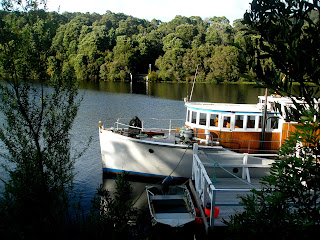Sadly, this will be the last blogpost from Tasmania. We are now back in Smithton, saying hello/goodbye to the family, before moving on to Devonport where we’ll spend Sunday night, leaving at 9 the next morning on the day ferry back to Melbourne.
The adventure does not end there, though, as we plan to return to the Central Coast via the high country of Victoria and NSW.
We have met some very interesting people in the past week. At Strahan, we noticed that the youngish man in the hired camper next to us was walking stiffly, and on asking what he’d done to his legs, found out he had run, yes RUN, the 82km Overland Track from Cradle Mountain to Lake St Clair the previous day. Normally it takes at least 3 days of walking, and more if the walker does some side trips.
 |
| The two intrepid walkers halfway around Dove Lake. |
This Nowra plumber does such bush marathons as a hobby. He finished the 82km in a bit over 9 hours, coming in 5th in the race, won by a chap who did it in 8 hours.
Then, when we reached Cradle Mountain, where we donned our own walking boots and took our time (about 2.5 hrs) to do the 6.5km circuit of Dove Lake, our neighbours in the campground were a young Hong Kong couple in a hired motorhome.
They’d come to Australia for their honeymoon. She had studied at the University of Qld and he had studied in Canada, and they had 10 days of wandering Tasmania to complete.
After Cradle Mountain, we really went bush, driving a back road to the west coast which goes along the top of the Reece Dam wall. Wonderful engineering, once again.
We took the little punt . . . and the truck just about filled the whole space, and was just under the length and weight allowed . . . across the Pieman River at Corinna, which we’d visited 2 years ago in a hire car. That time we stayed in one of the refurbished miner’s cottages . . . it had been a mining settlement in the 1800s . . . but this time we had a campsite.
 |
| The old huon pine launch that goes from Corinna to the mouth of the Pieman River. On the opposite bank is the southern road approach to the punt. |
We had a great meal at the pub, which is the centre of activity for the whole place, and at night, everything was wonderfully quiet, with no street lights.
The next night was even quieter, and totally black, as we went north on the dirt road called the Western Explorer, through melaleuca forests and then wonderful buttongrasss uplands, with the white quartzite gravel road winding on and on over the hills for about 70km, then dived into the Tarkine forests to stay at a Forestry picnic and camping area called Julius River.
It’s more of a rivulet and it ran just behind our campspot. It was a beautiful little glade, and we found the nearby rainforest walk utterly delightful, with fabulous huge old trees.
 |
| A poppy crop, near Smithton, with the pods ready for harvesting. Tasmania provides about half the world's requirements of medicinal opiates, suich as morphine and codeine.. |
To our special delight, along the road to this place, we spotted a young Tasmanian devil wandering on the road. He soon hightailed it into the scrub when he heard our engine, but that was the first one we’d seen. Later we saw a tiger snake (mostly black with subtle green striped belly) going about his business.
When we left Julius River this morning we wandered the forest roads for quite a time, even taking one that had foliage getting closer and closer on each side . . . and then suddenly we were out in farmland again and before long we were entering Smithton.
We have duly admired the cubbyhouse that John helped Nigel build before we left after Christmas. It is now completed, painted and decorated with all Erin’s favourite things, and we had afternoon tea with her on its verandah when she came home from school.
Thanks for staying with us during our two months in Tasmania. We have loved every moment and are quite sad to be going back to ‘the north island’, as the Tasmanians call it.



